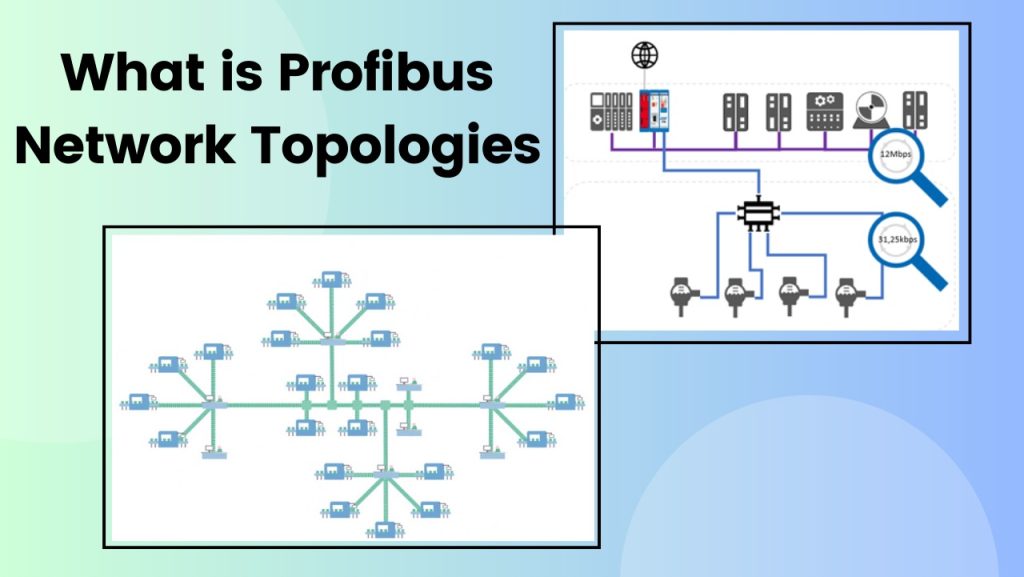A common industrial communication protocol called Profibus (Process Field Bus) enables devices in an automation system to communicate with one another. Different network topologies, which specify the physical arrangement and connectivity of devices in the network, are supported by Profibus.
The primary Profibus network topologies are shown below:
1. Profibus DP (Decentralized Peripherals):
The most popular network topology for decentralizedly connecting automation devices is profibus DP. In this topology, decentralised peripherals or slave devices converse with a central controller or master device through a two-wire bus. Each device in the network is linked to the one before it and the one after it in a daisy-chain configuration. Systems with a smaller to medium size should use this topology.
- Daisy-Chain Configuration: Devices in Profibus DP are linked together via a two-wire bus in a daisy-chain topology. The network has a linear topology since each device is linked to the one before it and the one after it.
- Centralized Control: The decentralised peripherals communicate with the central controller, typically a Programmable Logic Controller (PLC), to exchange data and control signals. The master device handles the data exchange process and starts communication.
- Flexibility and Scalability: When designing networks, Profibus DP offers scalability and flexibility. Without affecting the system as a whole, devices can be added to or withdrawn from the network with ease. It is therefore appropriate for situations where devices might be periodically extended or modified.
Check: 972-0DP20 VIPA Profibus Connector
2. Profibus PA (Process Automation):
Process automation applications, such as those found in the chemical, oil and gas, and pharmaceutical sectors, are the focus of Profibus PA. This topology facilitates communication with field devices like sensors, transmitters, and actuators and is based on the Foundation Fieldbus H1 standard. Devices connected through Profibus PA share a single twisted-pair cable for both power and data. Long cable distances are supported by the topology, which also enables device customization and diagnostics.
- Foundation Fieldbus H1 Standard: The Foundation Fieldbus H1 standard, which outlines the physical layer and communication protocol for devices used in process automation, is the foundation upon which Profibus PA is built. It offers a universal language for interfacing field instruments with control systems.
- Single Twisted-Pair Cable: Devices are linked together in Profibus PA using a single twisted-pair wire. The wiring architecture is simplified and installation expenses are decreased because this cable carries both power and communication signals.
- Long Cable Lengths: Devices can be placed far apart since Profibus PA permits lengthy cable lengths, generally up to several kilometres. It is therefore appropriate for process facilities with widely dispersed field devices.
3. Profibus FMS (Fieldbus Message Specification):
A supervisory control and data acquisition (SCADA) system and PLCs can communicate at a high level using the client/server network topology known as Profibus FMS. It offers a flexible and effective way to exchange bigger data quantities and is appropriate for sophisticated automation systems.
- Client/Server Communication: The foundation of Profibus FMS is a client/server communication model. The PLC or other networked devices (servers) receive messages or requests from the higher-level system (client).
- Message-based Communication: Messages are used by Profibus FMS to facilitate communication between client and server devices. Messages may provide instructions, data, and status details.
- High-Level Data Exchange: Larger data exchanges between the higher-level system and devices are supported by Profibus FMS. Complex data structures, configuration information, and process data can all be transferred via it.
Read: VIPA Profibus Connectors
4. Profibus DP/PA Hybrid:
In some instances, Profibus DP and Profibus PA are combined in the same network infrastructure using a hybrid network topology. This makes it possible to incorporate factory automation devices as well as process automation devices into a single system. The flexibility and scalability of the hybrid architecture allows for smooth connection between various types of devices.
- Dual Functionality: Both process automation devices (PA) and factory automation devices (DP) are supported by the Profibus DP/PA Hybrid architecture. This makes it possible for many device kinds to cooperate and communicate with one another within the same network.
- Common Network Infrastructure: The hybrid topology makes use of a shared network infrastructure, which streamlines the architecture of the entire system and lessens the difficulty of wiring and installation.
- Flexibility and Scalability: Adding or removing devices from the network without interfering with the communication between the process automation and factory automation devices is possible with the Profibus DP/PA Hybrid. This adaptability makes system expansion and reconfiguration simple.
- Process and Factory Automation Integration: The smooth coordination and data interchange between the two domains is made possible by the integration of factory automation devices and process automation devices in the same network. It enables thorough management and observation of the complete automation system.
- Shared Resources: Process and industrial automation equipment can share resources thanks to the Profibus DP/PA Hybrid topology. For instance, data-driven decision-making and system optimization are made possible by the ability of a PLC on the factory automation side to access process variables from the process automation devices.
In conclusion, the industrial automation system-specific needs, cost, scalability, and fault tolerance all play a role in the choice of Profibus network topology. The choice of topology should be dependent on the specific requirements of the application because each topology has advantages and trade-offs.





